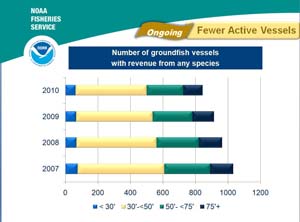Northeast groundfish vessel overall revenues up under new fishing rules
May 12, 2011
Total revenues increased for the Northeast groundfish vessels during the first nine months of the 2010 fishing year compared to same period in 2009.
High resolution (Credit: NOAA)
Under a new fisheries management program effective since last May, revenues increased for the Northeast groundfishery during the first nine months of the 2010 fishing year compared to same period in 2009.
Higher average prices for all species account for the increased revenues.
These are among the findings in an interim report released today by NOAA’s Northeast Fisheries Science Center. Researchers looked at gross revenues, fishing effort, average vessel performance, distribution of revenues, and employment for the first nine months of the 2007 through 2010 fishing years.
“The report provides welcome newsabout Northeast groundfish revenues,” said Eric Schwaab, assistant NOAA administrator for NOAA’s Fisheries Service. “For example, the higher revenues occurred without exceeding this year’s groundfish catch quotas. And while many fishermen are doing better, we also know that some fishermen and businesses are not doing as well.”
Researchers cautioned that it is too early to determine how new management measures affected individual groundfish businesses and communities. The analysis did not consider costs of fishing, but an annual report on the fishery to be issued in the fall will do so, and provide more information on profitability in the fishery during the 2010 fishing year.
“For this report, we built a general picture of conditions in the fishery in the first months of a new management system,” said Matthew McPherson, leader of the social science group that developed the study. “We found some trends already apparent continued in 2010, and that there are some more recent ones.”
The number of groundfish vessels actively fishing declined in the first nine months of fishing year 2010, an ongoing trend in the fishery during recent years.
High resolution (Credit: NOAA)
For example, groundfish revenues have become increasingly concentrated on the top earning vessels for a number of years. During 2007-2009, 20 percent of active groundfish vessels accounted for 66 percent of the total groundfish revenues. In 2010, 20 percent of vessels accounted for about 75 percent of the revenues from groundfish sales. Also, in 2010, active groundfish vessels fished less time and fewer vessels actually fished, indicating lower operating costs but reduced opportunities for crew employment.
Among the new trends are increased revenues and prices. Revenues from all species on all trips by groundfish vessels in the first nine months of 2010 were up about $24 million over the same period in 2009, with Massachusetts ports and vessels generating most of the increase, $16 million. Prices on average for all species were up about 15 percent over the 2007-2009 average.
Also, average revenue per unit effort (per day fished and trip taken) increased for most operations, suggesting improved economic performance over recent years. Vessels in all size categories averaged higher total revenues for all species in 2010 over 2009, with the largest vessels (more than 75 feet in length) exhibiting the largest average increase, 36 percent. Vessels in the 30 to 50 foot range had the smallest revenue increase, about 10 percent.
The report issued today examines revenues and effort at the vessel level, and evaluates performance by vessel size, vessel homeport, and principal port of landing. McPherson noted that future analyses at the business level will provide another way of evaluating the health of the industry. “Since one business may own more than one vessel, and some businesses may be closely allied with others, this evaluation may give us a very different picture than that based on individual vessel activity,” McPherson said.
Management measures which took effect in 2010 include annual catch limits to prevent overfishing and rebuild overfished stocks, and two options for controlling fishing effort. Fishermen can either form groups and fish an allotted share of the total allowed catch, or fish individually with a limit on the number of days spent fishing. Most vessels with a substantial history of landing groundfish are fishing under the catch share option, as a part of a group called a sector.
NOAA has committed more than $47.2 million to help the Northeast groundfish industry transition to the new management system.
To review the report in its entirety, please visit our website.
NOAA’s mission is to understand and predict changes in the Earth's environment, from the depths of the ocean to the surface of the sun, and to conserve and manage our coastal and marine resources. Visit us on Facebook.


